INSECT DECLINE
A cause for concern
by TurfPro Editor, Laurence Gale MSC, MBPR
All of us who work in the land-based industry should be more proactive in maintaining and preserving our unique bio-diverse habitats and landscapes for future generations.
As custodians of our landscape heritage we all need to play an active part in its future.
I read with concern, two BBC news stories last week that really brought that notion home to me . All of us who work in the land-based industry should be more proactive in maintaining and preserving our unique bio diverse habitats and landscapes for future generations.
Please read for yourself the two articles that we should all be concerned about.
Some key facts from the articles state that:
- Topsoil is being lost 10 to 40 times faster than it is being replenished by natural processes
- Since the mid-20th Century, 30% of the world's arable land has become unproductive due to erosion
- 95% of the Earth's land areas could become degraded by 2050
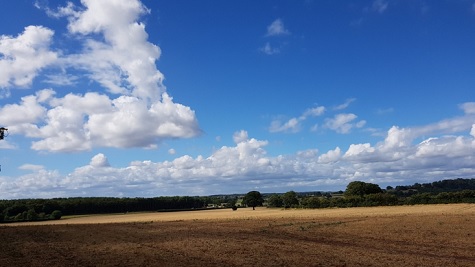
These matters are close to home for British politicians, the authors argue, with the average population sizes of the most threatened species in the UK having decreased by two-thirds since 1970. The UK is described as one of the most nature-depleted countries in the world.
- Some 2.2 million tonnes of UK topsoil is eroded annually, and over 17% of arable land shows signs of erosion.
- Nearly 85% of fertile peat topsoil in East Anglia has been lost since 1850, with the remainder at risk of being lost over next 30–60 years.
- A scientific review of insect numbers suggests that 40% of species are undergoing "dramatic rates of decline" around the world.
The study says that bees, ants and beetles are disappearing eight times faster than mammals, birds or reptiles. But researchers say that some species, such as houseflies and cockroaches, are likely to boom. The general insect decline is being caused by intensive agriculture, pesticides and climate change.
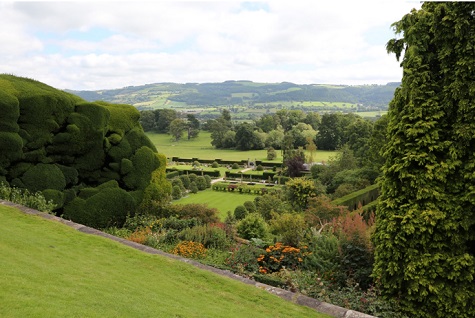
Insects make up the majority of creatures that live on land, and provide key benefits to many other species, including humans.
They provide food for birds, bats and small mammals; they pollinate around 75% of the crops in the world; they replenish soils and keep pest numbers in check.
Many other studies in recent years have shown that individual species of insects, such as bees, have suffered huge declines, particularly in developed economies.
The researchers found that declines in almost all regions may lead to the extinction of 40% of insects over the next few decades. One-third of insect species are classed as Endangered.
"The main factor is the loss of habitat, due to agricultural practices, urbanisation and deforestation," lead author Dr Francisco Sánchez-Bayo, from the University of Sydney, told BBC News.
"Second is the increasing use of fertilisers and pesticides in agriculture worldwide and contamination with chemical pollutants of all kinds. Thirdly, we have biological factors, such as invasive species and pathogens; and fourthly, we have climate change, particularly in tropical areas where it is known to have a big impact."
I am sure many of us who work within the sports turf and amenity sectors are acutely aware of these issues and have in recent years have been trying to address the decline of wildlife, insects and habitats. However, there’s no doubt we should be doing more.
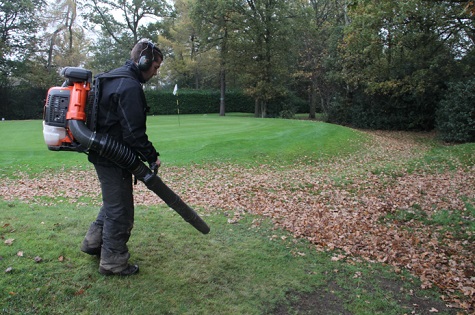
When was the last time you saw a hedgehog roaming outside your house? I have not seen one for a couple of years, mainly due to the loss of ground cover and hedgerows. Most new housing estates have much smaller gardens and many home owners have replaced their front gardens with gravel drives for parking. Hence a loss of habitat for local wildlife.
There are plenty of opportunities for us to halt the decline by taking action and improving the diversity of our neighbourhoods and places where we work.
Bob Taylor and his colleagues from the STRI, along with many dedicated greenkeepers have for many years being improving the biodiversity on golf courses. This mentality now needs to be driven to other land owners.
When I worked for the MOD as a grounds maintenance officer (GMO) we had great support from wildlife and habitat specialists to help preserve ecological important sites such a SSSI sites and historic woodlands.
English Heritage and the National Trust have also recognised the value of their properties and over the years have increased their management and maintenance regimes to increase the biodiversity of their sites.
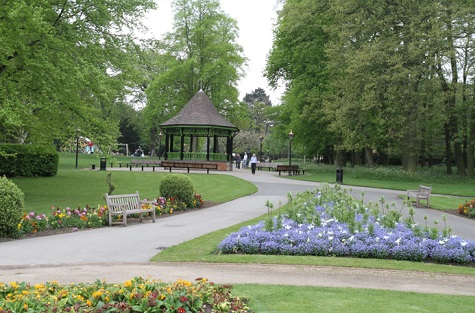
Parks and green space professionals are constantly searching for potential new approaches to managing public land in response to shrinking budgets and diminishing resources. Whilst it is hard to maintain enthusiasm for innovation when urgent cutbacks are the priority, the challenge of this generation of parks managers is to maintain quality whilst seriously cutting costs.
The movement to manage parks and green spaces more as nature reserves rather than gardens, has encouraged the development of longer grass and ‘wildflower meadow’ regimes in urban green spaces especially following the publication of the National Pollinator Strategy (2014) guidance. This management approach allows ecological and biodiversity quality to take precedence over either horticultural standards or the on-trend ‘cleansing’ approach to managing open spaces with its emphasis on tidiness.
Alongside, and in addition to, recent changes in mowing regimes, the past twenty years or so have seen the emergence of naturalistic, ecology-based, sustainable planting styles and maintenance regimes as an alternative approach to horticultural displays. These were developed early in Germany and the Netherlands and are now, at last, gaining some momentum in the UK - particularly following the stunning success of the Olympic Park planting for London 2012.
Several local authorities are also developing strategic wildlife corridors that run through their towns and cities creating a joined-up wildlife highway.
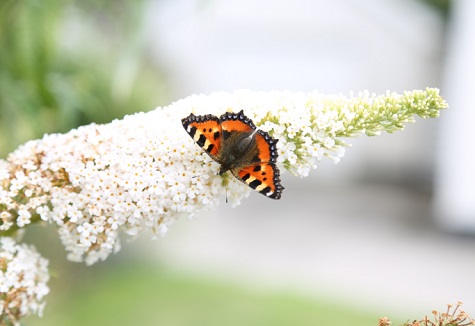
The key to all this is having a better understanding of what assets you are managing, taking time to learn about the topography and wildlife you have on your own doorstep and getting the right advice to manage these assets in way that sustains and increases its biodiversity.
We now have a vast array of tools and machinery at our disposal to help us maintain our land. We need to evaluate our assets and deliver a sustainable future for our wildlife and insect populations for the future.
There is great potential to enhance our land assets by evaluating and changing our maintenance practises to accommodate and increase biodiversity in many of our urban areas.
There are many tracts of urban open space that incudes schools, hospitals, industrial estates and road verges that could be enhanced to encourage more wildlife activity.
It is a time for change. We must start now! Each and everyone of us could make a difference by managing our own land space in a way to increase its biodiversity for the benefit of our wonderful urban wildlife, insects, flora and fauna.
 |
|
 |  |
RIGBY TAYLOR PARTNER WITH BIGGA
Two year deal
Rigby Taylor has announced a major sponsorship with BIGGA to tee off the company’s 100th anniversary campaign this year - a two-year sponsorship deal as a Golf Partner.
Rigby Taylor has announced a major sponsorship with the British & International Golf Greenkeepers Association (BIGGA) to tee off the company’s 100th anniversary campaign this year - a two-year sponsorship deal as BIGGA’s Golf Partner.
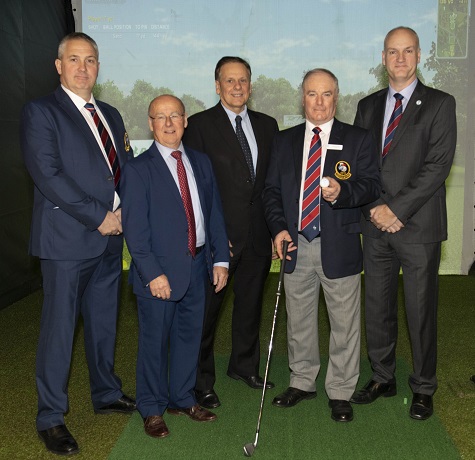
Outgoing BIGGA officers, chairman Les Howkins MG (left) and president Chris Kennedy (second right), with Rigby Taylor’s executive chairman, Chris Clark (centre) and marketing director Richard Fry (second left), and BIGGA chief executive Jim Croxton (far right)
The agreement includes BIGGA’s three annual golf tournaments:
- The National Championship
- The Golf Management Trophy and
- The Greenkeepers Benevolent Fund Golf Day.
Rigby Taylor will also be involved in all qualifying matches for each tournament and offering further support through the involvement of its key suppliers. In addition, where the opportunity exists, the company will provide technical advice on tournament preparation and product support.
Commenting on the announcement, Richard Fry, Rigby Taylor’s marketing director, said, “Rigby Taylor has a long history of supporting those who work in the golf industry and, as a founding member of BIGGA’s Golden Key Education initiative (as was), has always had a close relationship with the association.
“Our sponsorship of the BIGGA golf tournaments is the company’s expression of confidence in the industry and a vehicle for gaining closer ties not only with golf course managers and greenkeepers but also their greens committees and other key decision-makers.”
Jim Croxton, BIGGA CEO, added, “I’m thrilled that Rigby Taylor is supporting BIGGA in its golf activities for the next two years. The events are an opportunity to not only have some fun, but competitions such as the Golf Management Trophy also bring together all levels of the golf club structure, helping to build stronger relationships within teams and across barriers. And that’s incredibly important to us as an association.”
 |  |
SEVEN FOR SAWGRASS
John Deere Volunteer Programme
This year’s group of British and Irish greenkeepers are preparing for the experience of a lifetime as part of the John Deere TPC Sawgrass Volunteer Programme.
This year’s group of British and Irish greenkeepers are preparing for the experience of a lifetime as part of the John Deere TPC Sawgrass Volunteer Programme, organised annually in partnership with the British and International Golf Greenkeepers Association (BIGGA) and the Golf Course Superintendents Association of Ireland (GCSAI).

Pictured on the John Deere stand at BTME 2019 are (standing left to right) John Deere Limited turf division sales manager Chris Meacock, Jon Gamble, Darren Skinner, Mark Simmons, Alex Newenham, Niels Sorensen, GCSAI general manager Damian McLaverty and BIGGA chief executive officer Jim Croxton, with (seated left and right) Matt Shaul and Andy Copeland.
Held at the legendary TPC Sawgrass course in Ponte Vedra Beach, Florida, THE PLAYERS Championship regularly features more of the world’s top players than any other venue throughout the year, leading to its unofficial title of the fifth men’s major. As such it presents an incredible opportunity for BIGGA and GCSAI members to network, learn and gain a huge amount of invaluable experience, in a once-in-a-lifetime setting.
THE PLAYERS is made possible thanks to the hard work and dedication of a course preparation force of over 90 volunteers from around the world, who join the home greenkeeping team in getting and keeping the course in shape. Following the final day’s play, the greenkeepers also get the chance to attempt to hit the 17th hole’s intimidating island green.
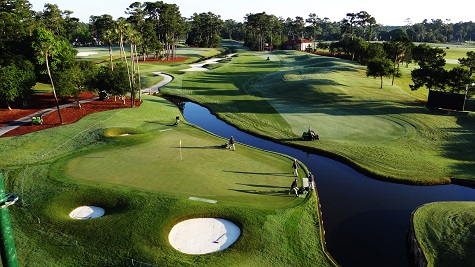
TPC Sawgrass
This year the event returns to its traditional March timing after 12 years of being hosted in May. The shift is the result of changes to the PGA Tour calendar and will see the greenkeeping team in 2019 undertake a very different challenge to that of preparing the course in May. The successful BIGGA and GCSAI members selected to join the volunteer team at the tournament, which takes place from March 14 to 17, are:
- BIGGA Scottish Region - Darren Skinner, Castle Stuart Golf Links
- Northern Region - Jon Gamble, Welshpool Golf Club
- Central England Region - Matthew Shaul, Cleethorpes Golf Club
- South West and South Wales Region - Mark Simmons, Kingsdown Golf Club
- South East Region - Andy Copeland, Chesfield Downs Golf and Country Club
- International - Niels Sorensen, Randers Golf Klub, Denmark
- GCSAI - Alex Newenham, Douglas Golf Club, Ireland.
John Deere Limited turf division sales manager Chris Meacock said: “I would like to congratulate all this year’s successful BIGGA and GCSAI members for winning through the rigorous selection process and earning a place on what will be our fifth annual TPC Sawgrass Volunteer Programme in 2019.
“The quality of applications that we receive each year is a true reflection of the high standards of greenkeeping and course management throughout the UK and Ireland. I know from the comments of past volunteers that this latest group will benefit greatly from the experience of being part of such a large, well-organised international greenkeeping team involved in the preparation of one of the world’s top golf tournaments.”
 |  |
NEW HYDROPONIC TURF SYSTEM
Looking for pilot clubs
Capillary Concrete has launched a new Hydroponic Turf System and is currently looking for golf clubs to participate in a pilot programme.
Capillary Concrete, best known as the supplier of golf’s scientifically advanced bunker liner product, has launched a new system for golf turfgrass management.
The company says their Hydroponic Turf System offers course managers the opportunity to make "huge reductions" in the amount of water needed to maintain high quality turfgrass, while at the same time promising major increases in turf health.
The system uses the capillary properties of Capillary Concrete to enable both drainage and irrigation from below and to precisely regulate the moisture content of the turf’s rootzone.
Martin Sternberg, Capillary Concrete inventor and CEO, said, “The system divides the turf into two areas of equal size. A control basin automatically oxygenates and pumps or drains water between the two areas on a regular schedule. The system is powered by a small solar panel and the water levels in the turf profile can easily be adjusted.”
The Hydroponic Turf System enables massive increases in gas exchange below the top four inches of the rootzone - the area which conventional aeration methods do not adequately service. Because carbon dioxide molecules are heavier than those of oxygen, the system pushes out the heavier molecules and sucks oxygen into the turf profile by raising and lowering the water table. It also delivers optimal levels of nutrients directly to the rootzone.
Sternberg said: “We have been researching this application of our technology for five years, and the results are remarkable. Irrigating from below virtually eliminates evaporation, and our tests show up to 85 per cent savings in total water used under our Hydroponic Turf System. Irrigation costs can be lowered by up to to 30 per cent, and the level of gas exchange in the rootzone can be increased by an almost unbelievable 6,000 per cent. Using hydroponics in this way will increase the lifespan of tees and greens, it will help superintendents deliver superior turf from dryer surfaces with lower maintenance costs and a much smaller environmental footprint.”
Capillary Concrete is currently looking for golf clubs to participate in a pilot programme to adapt the patented Hydroponics Turf System to local conditions and climates. Pilot partners will receive the new system, and also comprehensive support services enabling them to install, test and evaluate the benefits of the system for tees and greens. Interested clubs should contact Travis Chivers at Capillary Concrete by email travis@capillaryconcrete.com or by phone +1 (321) 929 4143.
 |  |
SIX YEAR SWARD CONVERSION PROGRAMME ON TRACK
At Sheringham Golf Club
With advice from course consultant Gordon Irvine, the club has undergone a transformation in recent years, with a push towards increasing fescue cultivars into the greens and fairways.
Norfolk’s Sheringham Golf Club has called on a duo of seeders from Charterhouse Turf Machinery to help their aim of achieving ‘continuous development’.
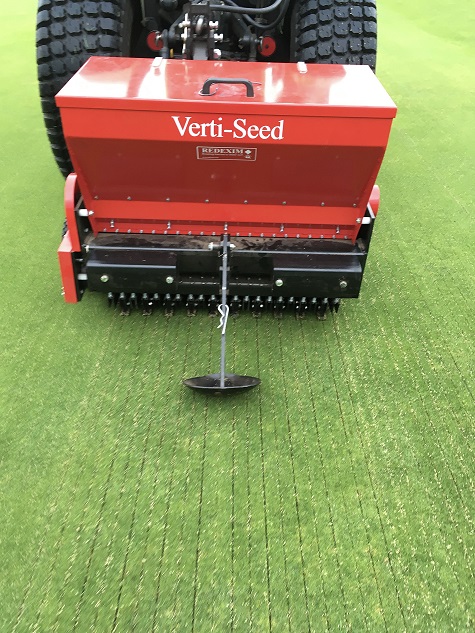
With advice from course consultant Gordon Irvine, the club has undergone a transformation in recent years, one of the biggest changes is the push towards increasing fescue cultivars into the greens and fairways.
Head greenkeeper, David Childs, has been at Sheringham for 23 years and is supported by a team of 6 greenkeepers.
“Our sward conversion programme has been in place for three full seasons and was kickstarted alongside investment in new machinery,” he explains. “We went for the Redexim Verti-Seed 804 for the greens as we were impressed with the gear system which meant we could easily and accurately control the amount of seed the machine was putting out. For fairways, we chose the larger Redexim Overseeder 1275.”
The current regime involves a double pass on the greens, in August and October. “The Verti-Seed is a really simple machine to set-up and leaves a nice smooth finish, which is key for the work on the greens. Because the seed is delivered straight down into the soil profile, we’ve been achieving fantastic uptake, even in the drier conditions. Following the work, the surfaces look great again in as little as a week which, as September is a very busy time for us, is important.”
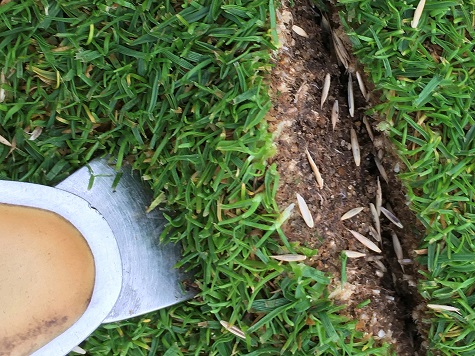
Two passes are also conducted with the Overseeder on the fairways, however, this tends to be later in the calendar, to capitalise on the increased moisture content therefore helping to maximise uptake.
“We estimate it’s going to be another three years or so on the current programme before we will then reassess. Increasing the fescue content will ultimately reduce our reliance on feeds and water, which will be positive for us. The Redexim machines are vital in achieving that outcome and to date, they’ve been producing the results we’ve been looking and hoping for.”
 |  |
RIBBLE AIM TO GET GAMES ON
With purchase of ShockWave
Ribble Valley Borough Council has invested in their own Imants ShockWave to help alleviate compaction and gets games on.
Ribble Valley Borough Council has invested in their own Imants ShockWave to help alleviate compaction and gets games on.
Chris Shepard, head gardener at Ribble Council has 14 sports pitches and the fields at Clitheroe Castle, a medieval construction that has been in place for 800-years, to look after as well as other non-sports areas across the Ribble Valley.
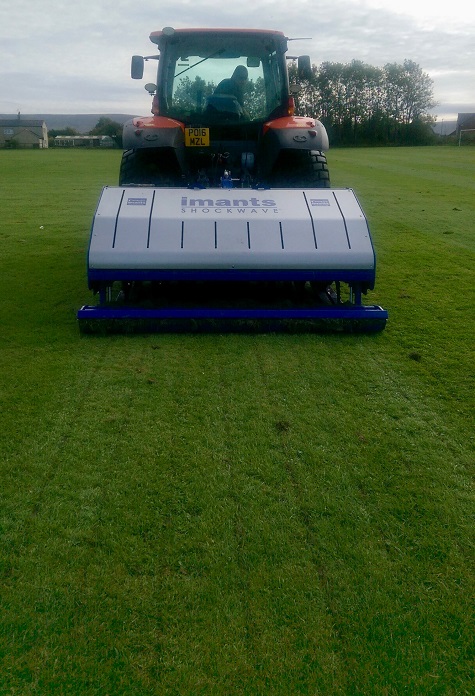
The council had a desire to improve the drainage on the pitches and prevent fixture cancellations while improving other areas that were less problematic. To achieve this the decision to purchase a ShockWave was made and it has had a busy start to life during its first three months in Lancashire with the difference already visible.
Chris said: “There were some pitches that had some standing water, but it had got to a point where we needed to do something regarding drainage for all of the pitches and the land to put money back into it and improve our facilities and we thought to get better use in the winter periods that the ShockWave was the way to go.
“There has been a difference in some of the pitches we’ve used it on. There was one area that would always hold water but that’s gone now. It’s still a bit softer underfoot than the rest of the field but you’re not squelching water like you would have been.
“Once we go on that area again, we’ll be able to go deeper and get down to 18 inches and that’ll definitely help.”
The ShockWave is specifically designed to revitalise heavy wear areas by relieving soil compaction and in turn improve aeration and remove surface water. When doing the linear aerator causes very little disturbance, to the point that play can continue virtually straight away.
For Chris this is an important factor when deciding when to deploy the machine because it can used close to fixture to provide maximum benefit without any risk of causing injury to players.
He said: “People can use the pitches on the same day we’ve used the machine and that’s a massive benefit because we don’t have to shut a pitch down for a week. It allows us to make a solid plan with the machine and work on the pitches when we want to and if an area needs to be worked on close to a fixture then we know that’s fine.”
 |  |
WEST LANCASHIRE GC PRAISES ICL
Believes H2Pro TriSmart makes the difference
Course manager, Stuart Hogg, says the product has provided his course with improved rooting.
Stuart Hogg, course manager at The West Lancashire Golf Club, believes that ICL’s H2Pro TriSmart provides him with everything he requires from a wetting agent.
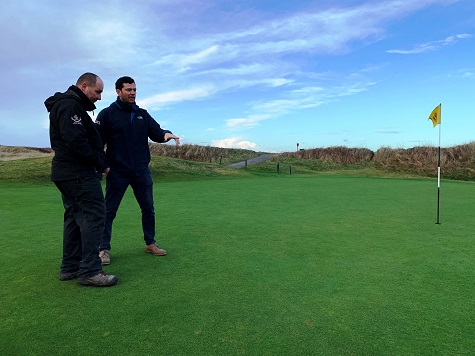
“The West Lancashire Golf Club is an amazing place to work,” said Stuart. “It is steeped in history and very well respected. You don’t appreciate how close the course is to the sea until you come and see it.”
Stuart, who has been in greenkeeping for just over thirty years, has been the course manager for four years and has worked exclusively at Links courses throughout his career.
“Does the sea bring challenges? No, because having grown up on Links courses I’m used to it. However, we probably dry out a lot quicker, we get wind burn, we get salt burn and we have to be more mindful of height of cuts.
“Choosing products that can work to fit our circumstances is the key. I’ve had a lot of experience with different products and I believe in finding an optimum product range. For me, that is predominantly ICL.”
The most recent addition to Stuart’s range of ICL products is the H2Pro TriSmart wetting agent.

Stuart starts the programme at the end of February and applies at a rate of 10L/ha every four to five weeks, depending on weather, until the end of July. Last year, he applied TriSmart to all of the greens and surrounds, which equates to an area size of 4 hectares, but due to the successful results the areas for treatment is set to significantly increase.
“With TriSmart I believe I got everything I was looking for in a wetting agent,” said Stuart. “Considering the season we encountered; we had improved rooting and I believe that was due to the fact that TriSmart was pulling the soil moisture down a little bit more. I also didn’t have to hand-water those areas at all which really helped in reducing irrigation and labour.
“This year we will be increasing the applications of TriSmart to use it on the greens, surrounds and now the fairways."
 |  |
MARATHON IS TENACIOUS FOR TROJANS
Heavy use on sports pitches
Head groundsman Dave Edwards says to ensure the turf stands up to the rigours of winter sports he uses Sherriff Amenity’s Marathon Sport extended release fertilisers.
Heavy usage on the sports pitches at the Trojan Club in Eastleigh, Hampshire, means that head groundsman Dave Edwards needs to ensure the turf stands up to the rigours of winter sports.
It is for this reason that Dave says he chooses Sherriff Amenity’s Marathon Sport extended release fertilisers.
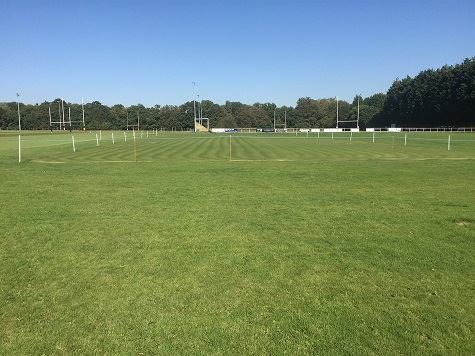
The Trojan Sports Club is a community-based amateur sports club which is run by the members, for the members and is open to all. The club receives no ongoing support from local or national sports authorities, and is totally reliant on member subscriptions, bar takings and fund-raising for its continued survival.
Trojan is one of the largest amateur sports clubs in Hampshire and has a long history of playing sport at a high level including rugby, hockey, squash, cricket and football.
Tasked with ensuring the quality and safety of the sports pitches is Dave Edwards, who aside from the help of volunteers two days a week, tends to the large site alone.
Dave has been in the turf industry for the entirety of his career and after a nine year spell as a groundsman at AFC Bournemouth, he went onto positions at Iford Golf Club, Christchurch F.C and Meyrick Park Golf Club before accepting the role of head groundsman at Trojan two and a half years ago.
It was in his previous employment that he first became acquainted with Sherriff Amenity’s Marathon Sport extended release fertilisers.
“I had previous experience of using the Marathon range and especially when I was at the football grounds - I didn’t really use anything else. I thought they were good slow release products which lasted an incredibly long time. In my opinion there are a lot of slow release products out there which are hit and miss and it can be a bit of a lottery but I was impressed with the Marathon range. In summer, the pitches used to really kick on when using them for the end of season renovations, so when I started here I thought it made sense to start using them again.”
Across the four rugby pitches, Dave’s maintenance programme sees him start the season with the Summer mixture 10.0.15, which he applies at 35g/m2 before turning to the Marathon Sport Autumn 7.0.21 to ensure good grass coverage over winter. Just through these two applications, Dave believes that it is all he needs to ensure the turf stays strong and healthy all year round.
“The products are very good in respect of providing the turf with a lovely colour and they are extremely hard wearing - it keeps the grass looking healthy but toughens it up as well which is what we need for the amount of usage. The pitches are used approximately 6-7 days a week through the winter and the slow release gives us great longevity, it doesn’t tail off after a few weeks."
 |
|
 |  |
ADVERTISE YOUR JOBS HERE
Amazing success rates!
Advertise your recruitment needs on TurfPro Weekly Briefing and reach our targeted audience of recipients every week.
Contact Nikki Harrison for details - 01491 837117
|
 |  |
 |  |
 |  |
 |  |
 |  |
WHAT IS BIOPHILIA?
The vital impact of parks and green spaces on health and well-being
by Bernard Sheridan, consultant, APSE (green space specialist)
Ever had that feeling of peace and tranquillity in natural surroundings, or longed for it when you brave the hectic city streets? That’s the ‘biophilia effect’.
Ever had that feeling of peace and tranquillity in natural surroundings, or longed for it when you brave the hectic city streets? That’s the ‘biophilia effect’.
W.B. Yeats nailed it in his poem the Lake Isle of Innisfree - “I hear lake water lapping with low sounds by the shore; while I stand on the roadway or on the pavements grey, I hear it in the deep heart’s core.”
The concept of biophilia was first used by the German psychologist Erich Fromm, for the instinctive bond between human beings and other living systems, which he considered part of the human ‘state of being’.
The term is arising more frequently in common usage, with many of the world’s great cities, including Birmingham in the UK, now acclaimed as ‘Biophilic Cities’, and even the Icelandic musical visionary, Bjork, devoting an album and performances to the concept. So what is it, and why is it important to green space professionals?
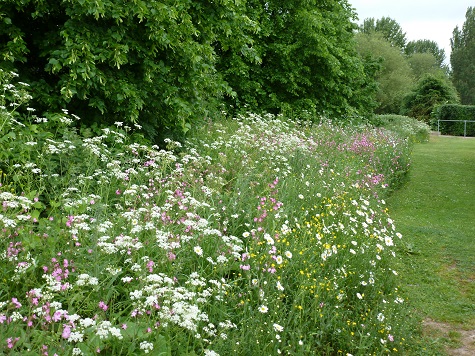
Native wildflowers sown in a natural open space
In the 1990’s Dr William Bird, a family GP from Berkshire started investigating biophilia following concerns about some of his patients who were finding it difficult to motivate themselves to exercise. He was aware of early research about health and green space and was so convinced of the efficacy of walking and taking exercise in parks and green spaces, as separate from the gym, that he collated together all available research to support his belief that nature is good for your health.
In 2007 he published a synopsis of his findings in his report for the RSPB and Natural England, Natural Thinking and his conclusions showed clearly that there was convincing evidence for the beneficial impact of being in green space on both physical and mental health. He started the Health Walk and Green Gym movements, which have spread across the world. In 2010 he was awarded an MBE for his work.
The evidence shows that merely being in good quality green space, even for only fifteen minutes, results in lowered blood pressure, reduced blood toxin levels, reduced stress, improved cognitive performance and enhanced memory retention; any physical exercise taken is a bonus.
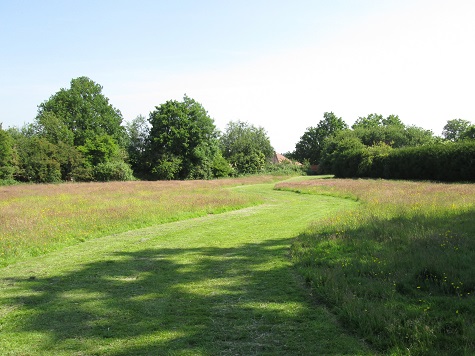
Grass left to grow, first year
Hospital patients overlooking green spaces and gardens recover quicker, have fewer complications and require less pain relief than those overlooking buildings or car parks.
The exact mechanism for this effect was not known but the research identified three main theories, none of which exclude the others, to explain how these underpinning health benefits work.
The Biophilia Hypothesis, proposed by the eminent biologist, Edward O. Wilson (who coined the term ‘biodiversity’) suggests that humans are genetically ‘hard-wired’ to be more contented and function better in natural environments, both physiologically, emotionally and cognitively.
He explains this is due to humankind evolving over hundreds of thousands of years, living with, depending on, and eventually manipulating nature, compared with the relatively miniscule time we have lived in urban environments.
Attention Restoration Theory proposes that compared with ‘hard’ indoor or urban environments, natural environments are more effective in allowing our brains to recharge and recover what is termed ‘direct attention’ or concentrated focus on a particular task. Concentration-demanding duties such as writing reports, developing spreadsheets, accounts, driving, studying etc. can be hard work and are important, but often uninteresting. They can soon tire the brain leading to negative symptoms such as displacement activity, distraction, irritability, anxiety and emotional reactivity. Being present in good quality green space helps our brains recover from fatigue, and this effect is currently recognised in many school’s activity plans
The third theory was the Psychological Stress Recovery Theory regarding the clear evidence for reduced blood pressure, pulse rate, blood stress-toxin levels, muscle tension and anxiety in people and patients within fifteen minutes of being present in green space. Like the biophilia explanation, this effect was thought to be the result of deep-seated genetic hard-wiring.
This effect even worked, to a lesser extent, when participants in trials were shown pictures or videos of landscapes. Interestingly, the most effective pictures at producing this effect showed undulating grassland, dotted with trees, a body of water, and evidence of human habitation, such as paths or a mid-distant dwelling.
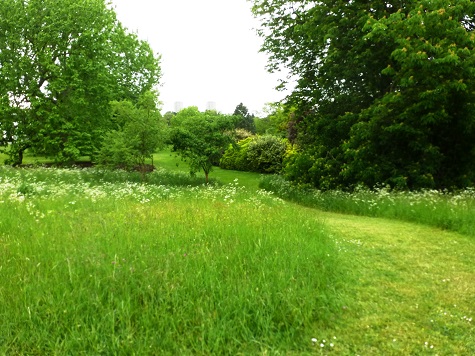
Long grass at Kew Gardens
Dr. Bird has continued his work and research and has presented to a number of seminars and forums recently, including the 2015 APSE Environmental Services Seminar.
He explained that humankind has evolved slowly over the last hundred thousand years, and for all that time we had to work closely with nature, understanding plants, animals, the land and water and the changing weather and seasons. For a mere fraction of that time, we have been living in urban environments. Even though towns and cities emerged about five thousand years ago there was, even then, reasonably close contact with nature; modern industrial urban environments are only a few hundred years old at most, and today’s high-tech urban living is now practically divorced from contact with nature. Now, 54% of the world’s population live in cities.
Meanwhile the human psyche and physique, which evolved for hunting and gathering, cannot keep pace with this rapid change. Is this disconnection with nature the underlying cause of the epidemics of obesity and other chronic diseases?
Dr Bird and many in the medical community believe this is obviously so. The widespread disconnection from nature, increasing loneliness, and living in hostile urban environments along with feelings of purposelessness and rejection from society gives rise to underlying chronic inflammation of the immune system –‘the cause of causes’

Was there ever any need to cut this grass?
This chronic inflammation which arises in children as young as six years old is linked to chronic stress and is a precursor of the diseases of modern living, including obesity, cancer, cardio-vascular disease, diabetes, arthritis, anxiety and depression. The pathway seems clear -chronic inflammation causes stress, leading to ‘comfort’ over-eating and physical inactivity which causes build-up of visceral fat. Visceral fat is an underlying factor in all these conditions and its presence increases mortality risk. These conditions all feedback on each other and can have a multiplier effect –visceral fat can cause further inflammation leading to more stress and so on.
Treatments geared to weight loss alone are insufficient as visceral fat can remain untouched, despite losing weight by dieting. By contrast visceral fat can reduce markedly after physical activity even though body weight remains the same.
The precise mechanism, for the medically-minded, seems to be as follows-visceral fat requires physical activity to reduce it -contracting muscle acts almost like a gland by secreting anti-inflammatory myokines; (Google it!) myokines release lactoferrin that switches off the immune system after a high fat high sugar meal. This means that the energy is retained by the brain and does not inflame the immune system, resulting in releases of brain-derived neurotrophic factor which fights harmful neuro-generative processes; this reduces the onset of Type 2 Diabetes, increases connectivity between neurones and improves mitochondrial function in the brain. In short, physical activity is fundamental to health and human survival and reduces the impact of chronic inflammation and stress.
So, why do we need healthy landscapes, and why does nature make us less stressed? As outlined previously, both the body and mind benefit from the ‘biophilia effect’ in green spaces -we are reconnected with nature and, very quickly, our chronic stress levels are reduced. There are the direct effects of nature on the brain; in good green space there are less bad things, less noise, pollution, excess heat, poor aesthetics and more enjoyment and opportunities for physical activity and social interaction. This means that the benefits of any physical activity in green spaces are significantly heightened.

Eye-catching annual flowers on a Leicestershire highway
However, research has shown that, as previously mentioned, the benefits of the biophilia effect depend greatly on the quality of green space. Not unexpectedly, evidence reveals our preference for sites to be readily accessible, pleasant, welcoming and appropriately maintained -free from urban nasties such as litter, vandalism damage and graffiti. People need to feel safe, unthreatened and comfortable. There needs to be variation and variety in landform, features, planting and terrain; with colour, texture and naturalness, but with sufficiently clear arrangement and vistas, and with places of shelter to prevent it being a threatening wilderness.
The implications for health services, schools, universities and mental health carers of the phenomenon of improved physical health, mental wellbeing and happiness, through connection with nature and outdoor exercise, is only just beginning to register. The impact on education services and child physical and cognitive development, on tackling the obesity and diabetes crisis, and on the caring professions should be profound. Every year, more research exposes the amazing healing and health-supporting properties of green spaces yet, somehow, every year parks and green spaces become more politically invisible and their importance declines.
Dr Bird is about to publish a book of his collected wisdom and findings, The Oxford Textbook of Nature and Public Health, and his experience in promoting active lifestyles and building active communities. It is likely to be, and deserves to be, a game-changer for the green space sector. It will provide clear evidence for the sector to promote , and I urge all professionals and enthusiasts to familiarise themselves with, and take on board its important message -and then use it to promote the role of quality green spaces and physical activity throughout society.
 |
|
|
|